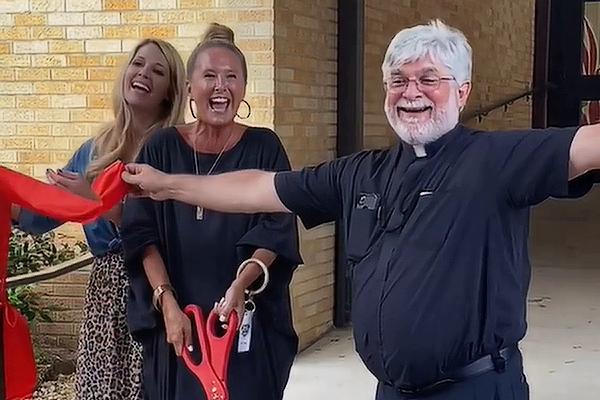

Our Lady of the Holy Souls School in Little Rock is banking on the fact that students need to be better prepared for high school and math and science careers by building a $2-million addition to the school.
After nearly two years of construction, former pastor Father John Marconi, who became a senior priest July 1, returned to campus July 21 to help principal Amber Bagby and assistant principal Sarah Richards cut the ribbon at the grand opening of the building, which features a Science, Technology, Engineering, Arts and Math (STEAM) lab, new offices, tutoring and therapy rooms and pre-kindergarten classrooms.
“All of the things that we’re going to bring into the school and into the classroom will be all new experiences for the kids and will create opportunities for deeper learning,” said Jill Wingfield, who this summer was promoted from science teacher to STEAM lab director. “It's just like I've always wanted it. It’s a science teacher’s dream job.”
The lab features cutting-edge technology, including 30 virtual reality headsets, six 3D printers, and a 60-inch smartboard that is like a giant electronic tablet and allows interaction between teachers and students.
Working in VR will allow Wingfield to bring new opportunities to the students. Each headset comes with a handheld controller so that students may move freely in the virtual world while remaining seated at their desks. She has already worked on lesson plans, including one that allows students to “hold” a virtual human heart in their hands and see how blood moves through the organ, is oxygenated and pumped through the body.
“You can’t do that with a dissection,” she said.
Wingfield said students will still have traditional science classes, as the STEAM lab was designed to supplement learning across the school’s curriculum from kindergarten through eighth grade.
“It doesn't take away traditional hands-on learning,” she said. “They’ll be met with a challenge that will coordinate with a lesson that came from their classroom, and their classroom teachers will get to experience it as well so, they can build on that learning.”
For instance, geography classes can use the STEAM lab to virtually explore an active volcano.
“The whole class could be there. So, I can see you and you can see me. There might be ash falling where I am because I'm closer and not where you are. And so, it creates a much deeper discussion from the virtual experience that we truly learn from and create memories with.”
For history classes, a virtual trip to Greece to see the Parthenon is scheduled. There’s an option to build a virtual world, like the popular video game Minecraft, where students can use their knowledge of the ancient world to create a modern-day Acropolis and invite other students to explore it.
Bagby said teachers are undergoing training to acclimate them to the lab and its possibilities to supplement their lessons.
“Jill has worked all summer, more hours than I have, doing trainings and trying to get everything ready,” Bagby said. “School can become kind of mundane, and you don't learn when you're not excited. This is going to bring a lot of excitement.”
As an administrator, Bagby has to not only worry about her students’ education, but also the school’s bottom line. She says the STEAM lab will have a significant impact on the school’s ability to recruit families and enroll students.
“On top of everything that we already have, of who we are and what we are, it sets us apart,” Bagby said. “There are a lot of schools that say they’re a STEM school, but it’s actually very minimal. Today, most of the curriculums are written with a STEM component, but this stands alone and really points to the caliber of education we want to provide.”
Bagby credited Father Marconi and previous principals Ileana Dobbins and Nancy Handloser for having the vision and launching a capital campaign for the addition.
“Father John had the courage, the backbone to say, ‘Let's do it.’ They were the ones that planted the seed, and then our community believed in them enough to say, ‘OK.’ We couldn't have done it without them, the parents and the community.”
Please read our Comments Policy before posting.
Article comments powered by Disqus Bishop Taylor announces more pastoral appointments
Bishop Taylor announces more pastoral appointments
 Apply now for diocesan School of Spiritual Direction
Apply now for diocesan School of Spiritual Direction
 Parishes are deepening faith, bonds during revival year
Parishes are deepening faith, bonds during revival year
 Mary on the Mantel guides Holy Souls School students
Mary on the Mantel guides Holy Souls School students
 St. Nicholas campaign art winners selected
St. Nicholas campaign art winners selected
 Studio 3:16 offers new approach to teaching religion
Studio 3:16 offers new approach to teaching religion
 CHS athlete overcomes odds to reach collegiate goal
CHS athlete overcomes odds to reach collegiate goal
 John Calipari: UA basketball coach and devout Catholic
John Calipari: UA basketball coach and devout Catholic
 'Cabrini' film tells story of saint with great faith
'Cabrini' film tells story of saint with great faith
 Bishop Taylor announces more pastoral appointments
Bishop Taylor announces more pastoral appointments
 St. Joseph a model of solidarity with immigrants
St. Joseph a model of solidarity with immigrants
 Two gifts after Jesus’ death: Virgin Mary and Eucharist
Two gifts after Jesus’ death: Virgin Mary and Eucharist
 Why we have an altar, and not just a communion table
Why we have an altar, and not just a communion table
 Pope: Wars should be resolved through nonviolence
Pope: Wars should be resolved through nonviolence
 Living relationship with Jesus Christ in the Eucharist
Living relationship with Jesus Christ in the Eucharist